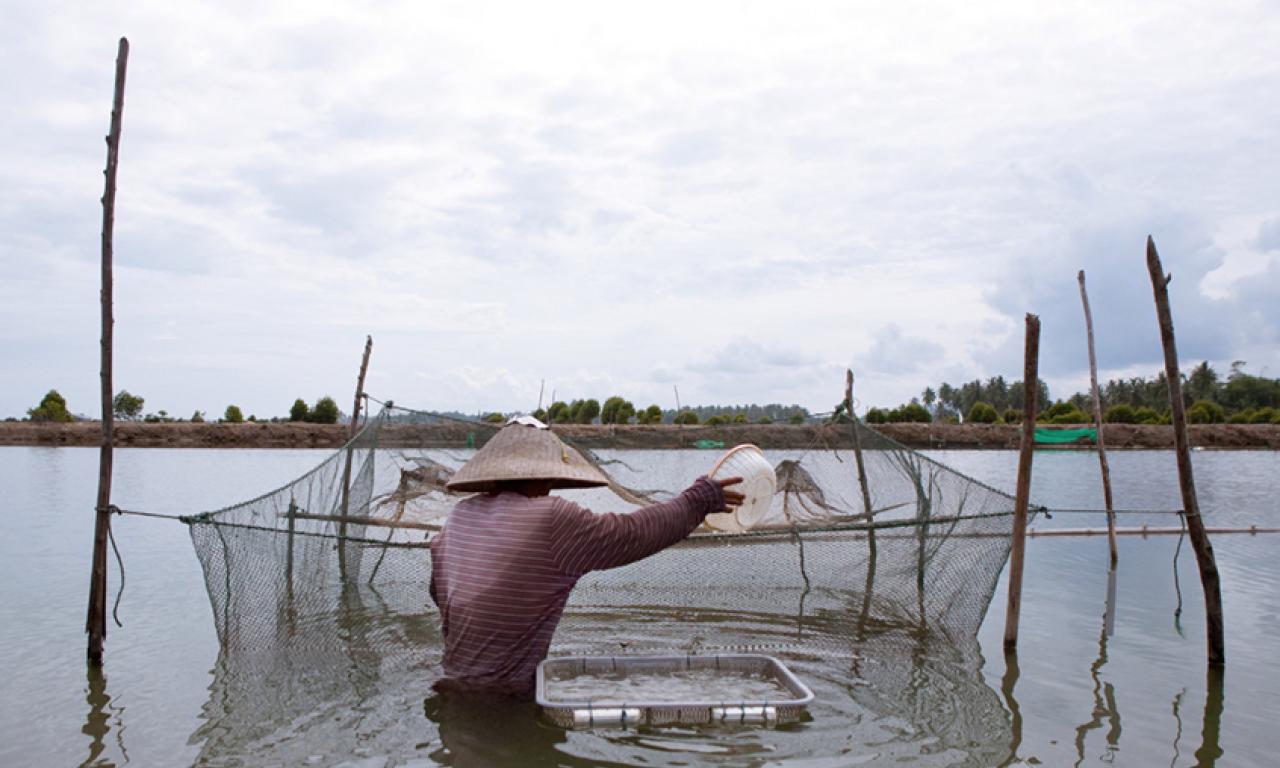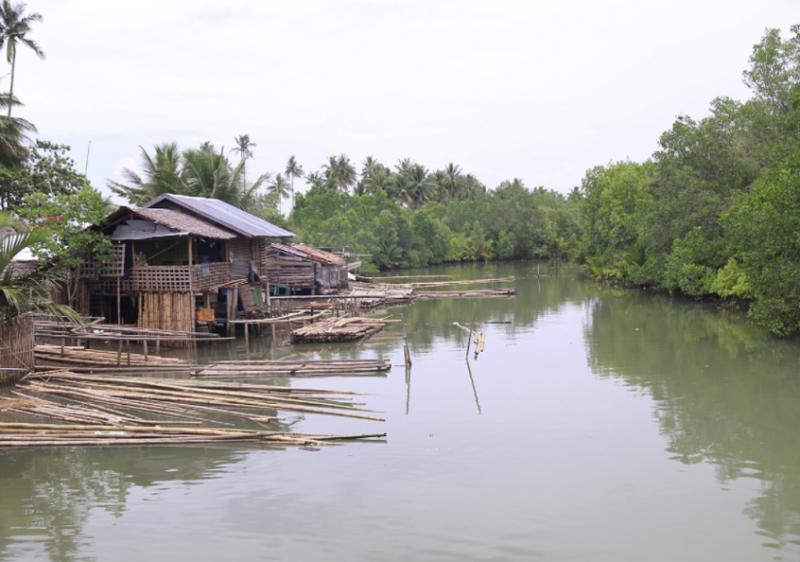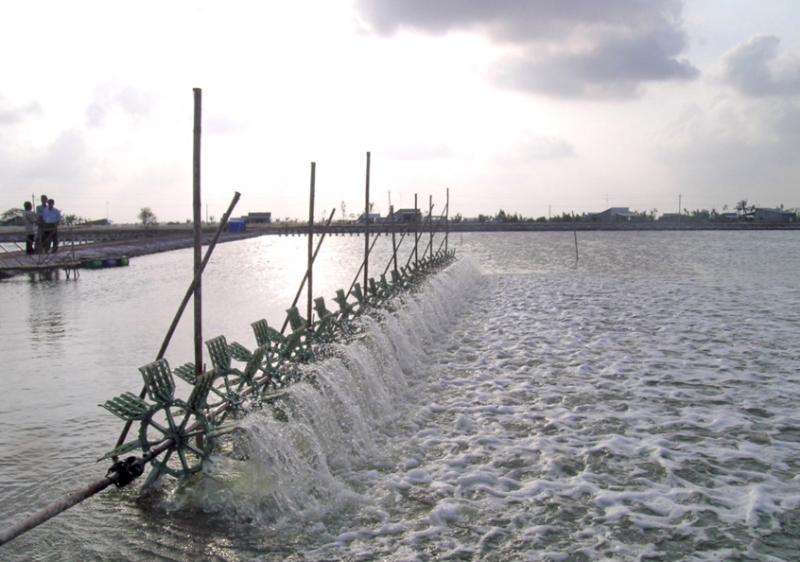
A recent paper stating that farmed shrimp has a ‘jumbo’ carbon footprint is an overestimate, say WorldFish and partner researchers, largely because it fails to account for the greatly reduced competition between shrimp farms and mangrove forests as well as an increased recognition of the value of mangroves.
Recommended publications
- Blue frontiers: Managing the environmental costs of aquaculture
- The devil is in the detail – the carbon footprint of a shrimp
A recent paper stating that farmed shrimp has a ‘jumbo’ carbon footprint is an overestimate, say WorldFish and partner researchers, largely because it fails to account for the greatly reduced competition between shrimp farms and mangrove forests as well as an increased recognition of the value of mangroves.
Instead, the researchers are calling for a closer look at the current methods used in shrimp production to estimate more accurately the carbon footprint of the burgeoning shrimp industry.
Competition between shrimp farms and mangrove forests
Around 34% of the world’s shrimp production comes from Southeast Asia. In these tropical countries, shrimp farms often result in the removal of mangrove forests, explains Patrik Henriksson, a post-doctoral researcher at the Stockholm Resilience Centre and a WorldFish consultant.
“Since the early 1970s, when a number of Southeast Asian governments started promoting semi-intensive and intensive shrimp production, large areas of mangroves have been cut down to make way for potentially high-earning shrimp ponds.”
Mangrove trees grow in areas of waterlogged soils, where fine sediments accumulate due to slow-moving waters. In these environments, mangroves hold large amounts of carbon that is stored for centuries, mostly below the ground. The majority of this is released when the mangrove is transformed into aquaculture ponds.

However, says Henriksson, the rate of mangrove conversion to aquaculture ponds has greatly reduced over the last decade. “A key reason is that an increasing number of countries are starting to recognize the many ecosystem services these forests provide.”
In Thailand and Vietnam, for example, greater efforts are being made to conserve the remaining mangrove forests, by disallowing ponds to be established in mangrove areas. This will reduce the land use and land use change emissions related to shrimp farming.
Lifetime of shrimp ponds
The assumed lifetime of a shrimp pond is another important consideration, as emissions are annualized or amortized over this time period. The longer a pond can be used, the less land is needed and, consequently, the lower the overall carbon footprint of farmed shrimp will be.
Some research suggests that shrimp ponds are only actively used for between 5 and 10 years, a period that research shows is too short, says Henriksson.
“Research by WorldFish and others finds that extensive shrimp farms, where shrimp are farmed in relatively large ponds at low density and with few inputs, are used for 50 years or more. And even in intensive systems, where shrimp is raised at high densities on commercial feeds, improved farming practices have greatly improved the long-term productivity of ponds.”
In Thailand, for instance, the use of compound feeds, paddle wheels, sediment removal and probiotics has helped extend the lifetime of intensive shrimp farms and improved the livelihoods of shrimp farmers. Proper feed management reduces sediment build-up, paddle wheels aerate water and sediments, and probiotics promote better overall pond conditions.
Stocking density of production systems
Today, more than half of all farmed shrimp is produced in semi-intensive or intensive production systems, with high stocking densities of up to 35 metric tons per hectare.
Despite this, some carbon footprint estimates, including that given by Kauffman et al., are based solely on low-yielding extensive systems, explains Henriksson.
“For example, mixed mangrove-shrimp systems in the Mekong delta—where shrimp is grown in canals dug throughout the mangrove forest with two-thirds of the mangrove left intact—only produce 250–300 kg/year/hectare. So large areas of land are being used to produce relatively small amounts of shrimp,” he says.

In addition, large volumes of wild shrimp, crabs and fish are also harvested from these systems.
“This fact is sometimes overlooked when calculating a shrimp’s carbon footprint, resulting in the shrimp, which is only a co-product in mixed-mangrove systems, being allocated all of the greenhouse gas emissions related to the mangrove removal. At WorldFish, our research shows that when co-production is taken into account, the carbon emissions allocated to shrimp are often half or less of the overall emissions.”
Way forward for farmed shrimp
Clearly, there is no ‘average’ way to farm shrimp. The diversity comes, in part, from the rapid expansion of farmed shrimp that began in the 1970s.
This growth has led to a more than fourfold increase in the availability of crustaceans, which includes both prawn and shrimp, from 0.4 kg in 1961 to 1.8 kg in 2013. Today, shrimp is the second-most traded seafood commodity globally.
At the same time, this growth has contributed to greenhouse gas emissions and hampered carbon sequestration—the process of removing carbon dioxide from the atmosphere.
With no slowdown expected in global demand for shrimp, which is driven mostly by consumers in developed countries, efforts to improve the productivity and sustainability of shrimp farming in developing countries will become ever more important.
So far, the evidence indicates that we are on the right track. The value of mangroves is increasingly being recognized and efforts by WorldFish and others to train farmers are leading to better feeding regimes and management practices, all of which can reduce the carbon footprint of farmed shrimp.